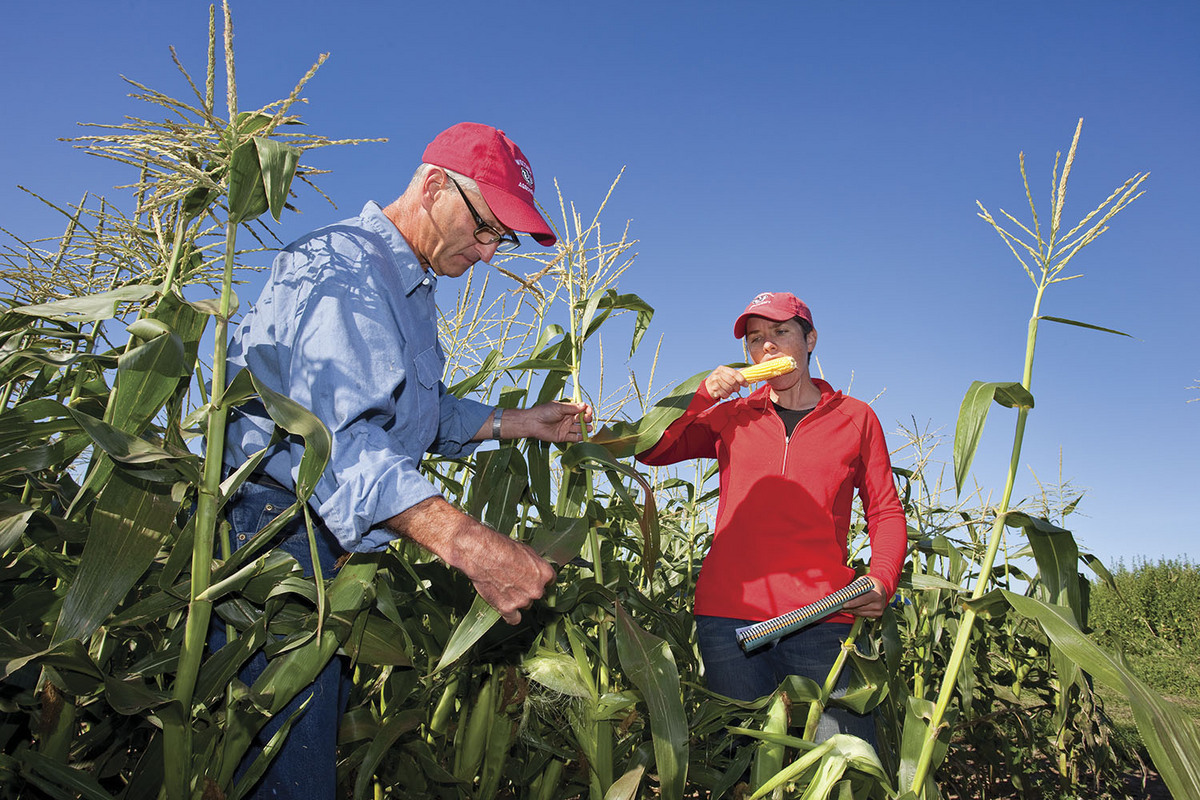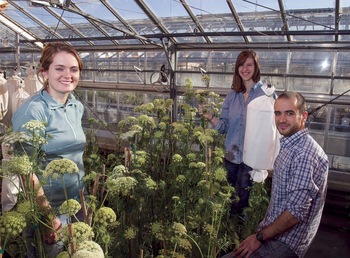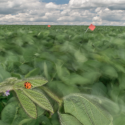New report profiles UW-Madison organic agriculture research

Professor Bill Tracy and graduate student Adrienne Shelton sample their organic sweet corn in the field at the West Madison Agricultural Research Station.
Photo: Wolfgang Hoffmann
University of Wisconsin–Madison scientists are engaged in a wide range of research related to organic agricultural production practices, according to a new report released on Feb. 28 at the MOSES Organic Farming Conference in La Crosse.
The report, published by the UW–Madison Center for Integrated Agricultural Systems (CIAS) and the Wisconsin Department of Agriculture, Trade and Consumer Protection, summarizes 23 studies conducted by researchers in the university’s College of Agricultural and Life Sciences (CALS) in partnership with farmers across the state. The scientists are evaluating production practices for many of the state’s main agricultural products — dairy forages and pasture, soybeans, potatoes, vegetables and fruits, among others — as well as farm management and marketing.
The report also takes a more in-depth look at how some of the organic research projects have benefited the state’s farmers. For example, UW plant pathologists Ruth Genger and Amy Charkowski are working with producers across the Upper Midwest to improve organic seed potato production and develop new organic varieties suited to the region. Those producers include Kat Becker and Tony Schultz, who tested the UW scientists’ Papa Cacho potato on their Community Supported Agriculture farm in Marathon County.

Students Amy Freidig, Lynn Maher and Gregory Vogel work with carrots and beets in the Walnut Street Greenhouses on the UW–Madison campus.
Photo: Sevie Kenyon
“This variety did really well in a horrible drought,” Becker reports. “It’s done well in freezing cold, low-nitrogen environments. And it’s commercially viable for us, giving us a variety that no one else has.”
The report also profiles organic no-tillage research being conducted by Erin Silva, a scientist in CALS agronomy department and CIAS. No-till practices require less fuel and labor, reduce erosion and improve soil, but because conventional no-till techniques require herbicides, organic farmers have not been able to capture the benefits, Silva points out. For the past eight years, she has been working on a no-till system that involves planting a cover crop in the fall, killing it in the spring with a mechanical roller/crimper, then planting a grain or seed crop directly into the remaining mulch.
This system has worked well for organic dairy farmer Jim Miller, who used it to plant soybeans into a rye cover crop on his family’s fifth-generation farm near Columbus. “That was probably the nicest field we have ever seen,” he says. “There might have been five weeds in the entire field. It was beautiful and yielded very well. If the stand of rye is thick and the yield is good, this definitely translates into savings.”
While the UW’s organic research has clear benefits for the state’s 1,100 organic producers, it also can help those who employ conventional farming practices.
This is an appropriate year to highlight UW organic agriculture research, notes CALS Dean Kate VandenBosch in the report’s introduction. The college, which itself turns 125 in 2014, is celebrating the 25th anniversary of two key initiatives focused on sustainable and organic agriculture. One is CIAS, which was started in 1989 to build UW sustainable agriculture research programs. The other is the Wisconsin Integrated Systems Cropping Trial, established to investigate the sustainability of diverse rotations and other low input measures. WISCT, which is profiled in the report, is one of the nation’s longest-running trials that includes organic management.
While the UW’s organic research has clear benefits for the state’s 1,100 organic producers, it also provides a lot of information that can help those who employ conventional farming practices, points out UW-Extension entomologist Russell Groves, who evaluates both organic and conventional pest control practices for use in vegetable production.
“The organic producer has to be especially attuned to varieties that resist or tolerate pests more, and non-chemical means of control — things like exclusions, row covers, trap crops, sanitation — but our commercial growers can certainly benefit from the same information,” Groves says.
Read “Organic Agriculture in Wisconsin: 2014 UW–Madison Research Report.”
Subscribe to Wisconsin Ideas
Want more stories of the Wisconsin Idea in action? Sign-up for our monthly e-newsletter highlighting how Badgers are taking their education and research beyond the boundaries of the classroom to improve lives.



